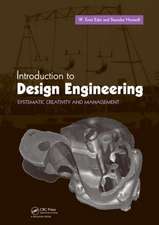Mental Models: Design of User Interaction and Interfaces for Domestic Energy Systems
Autor Kirsten M. A. Revell, Neville a. Stantonen Limba Engleză Hardback – 21 apr 2017
Preț: 625.44 lei
Preț vechi: 876.93 lei
-29% Nou
Puncte Express: 938
Preț estimativ în valută:
119.68€ • 125.21$ • 99.42£
119.68€ • 125.21$ • 99.42£
Carte tipărită la comandă
Livrare economică 02-16 aprilie
Preluare comenzi: 021 569.72.76
Specificații
ISBN-13: 9781498762175
ISBN-10: 1498762174
Pagini: 312
Ilustrații: 83
Dimensiuni: 156 x 234 x 24 mm
Greutate: 0.48 kg
Ediția:1
Editura: CRC Press
Colecția CRC Press
ISBN-10: 1498762174
Pagini: 312
Ilustrații: 83
Dimensiuni: 156 x 234 x 24 mm
Greutate: 0.48 kg
Ediția:1
Editura: CRC Press
Colecția CRC Press
Public țintă
Academic and Professional Practice & DevelopmentCuprins
Contents
List of Figures
List of Tables
Preface
Acknowledgements
Authors
List of Abbreviations
Chapter 1 Introduction
Chapter 2 Models of Models: Filtering and Bias Rings in Depiction of Knowledge Structures and Their Implications for Design
Chapter 3 The Quick Association Check (QuACk): A Resource-Light,‘Bias Robust’ Method for Exploring the Relationship between Mental Models and Behaviour Patterns with Home-Heating Systems
Chapter 4 Case Studies of Mental Models in Home Heat Control: Searching for Feedback, Valve, Timer and Switch Theories
Chapter 5 When Energy-Saving Advice Leads to More, Rather Than Less, Consumption
Chapter 6 Mind the Gap: A Case Study of the Gulf of Evaluation and Execution of Home-Heating Systems
Chapter 7 Using Interface Design to Promote a Compatible User Mental Model of Home Heating and Pilot of Experiment to Test the Resulting Design
Chapter 8 Mental Model Interface Design: Putting Users in Control of Their Home-Heating Systems
Chapter 9 Conclusion
Appendix A: The Quick Association Check
Appendix B
References
Bibliography
Index
List of Figures
List of Tables
Preface
Acknowledgements
Authors
List of Abbreviations
Chapter 1 Introduction
Chapter 2 Models of Models: Filtering and Bias Rings in Depiction of Knowledge Structures and Their Implications for Design
Chapter 3 The Quick Association Check (QuACk): A Resource-Light,‘Bias Robust’ Method for Exploring the Relationship between Mental Models and Behaviour Patterns with Home-Heating Systems
Chapter 4 Case Studies of Mental Models in Home Heat Control: Searching for Feedback, Valve, Timer and Switch Theories
Chapter 5 When Energy-Saving Advice Leads to More, Rather Than Less, Consumption
Chapter 6 Mind the Gap: A Case Study of the Gulf of Evaluation and Execution of Home-Heating Systems
Chapter 7 Using Interface Design to Promote a Compatible User Mental Model of Home Heating and Pilot of Experiment to Test the Resulting Design
Chapter 8 Mental Model Interface Design: Putting Users in Control of Their Home-Heating Systems
Chapter 9 Conclusion
Appendix A: The Quick Association Check
Appendix B
References
Bibliography
Index
Recenzii
"This is a valuable piece of work for most, if not all, interface designers practicing user-centered design in the industry. The mental models methodology and approach discussed in the book benefits not only on reduction of energy consumption in domestic energy systems, but also helps readers in understanding the behavior and behavioral changes of consumers in other design domains. I would believe a wide range of researchers and practitioners would be interested in the practical examples, insights and guidance provided by the two experienced authors in this book."
— Alan HS Chan, City University of Hong Kong
"When Stanton and colleagues address a topic, it’s important to pay attention to what they have to say. I recently heard a famous inventor talk about the difference between unintended, unanticipated, and perverse consequences of innovation. This book on mental models for home energy systems gives me a great working example of this complex aspect of sociotechnical impacts of technology innovation."
— Barrett Caldwell, Purdue University, Indiana, USA
— Alan HS Chan, City University of Hong Kong
"When Stanton and colleagues address a topic, it’s important to pay attention to what they have to say. I recently heard a famous inventor talk about the difference between unintended, unanticipated, and perverse consequences of innovation. This book on mental models for home energy systems gives me a great working example of this complex aspect of sociotechnical impacts of technology innovation."
— Barrett Caldwell, Purdue University, Indiana, USA
Descriere
There is a resurgence of interest in mental models due to advances in our understanding of how they can be used to help design and due to the development of practical methods to elicit them. This book brings both areas together with a focus on reducing domestic energy consumption. The book focuses on how mental models can be applied in design to bring out behaviour change resulting in increased achievement of home heating goals (reduced waste and improved comfort). This book also offers a method to extract and apply mental models to interface design. The approach enables mental models to be applied across domains when behaviour change was sought, and is validated as a useful design method.


















